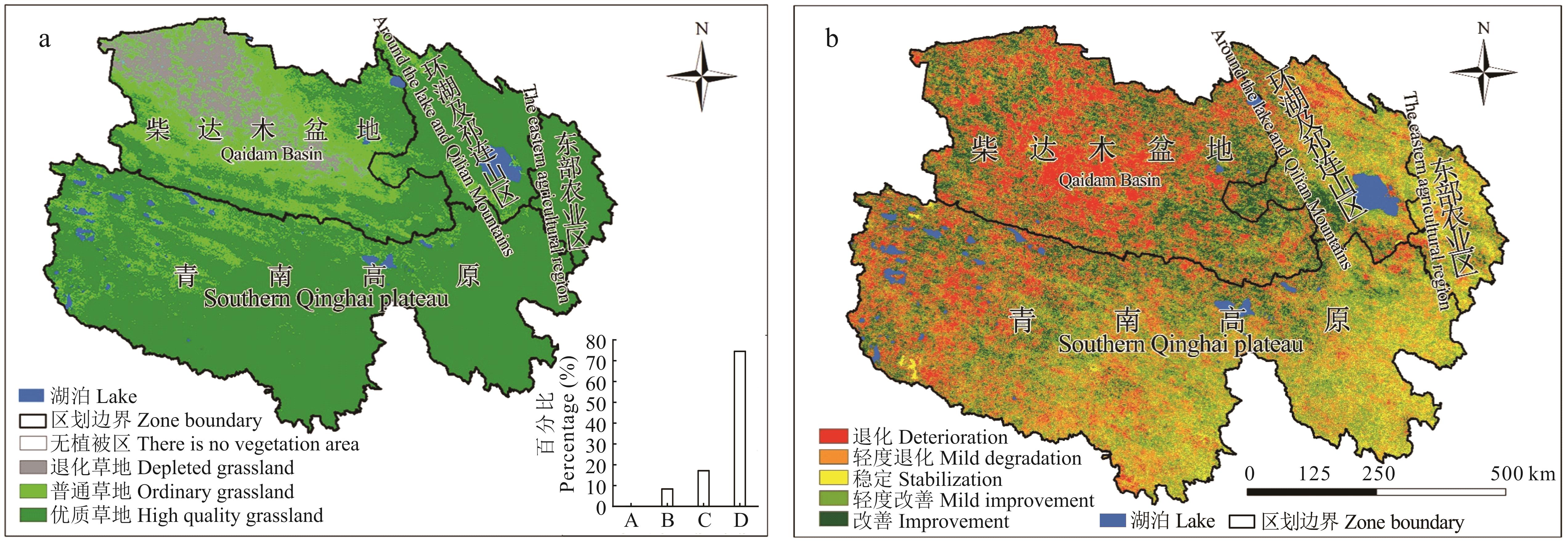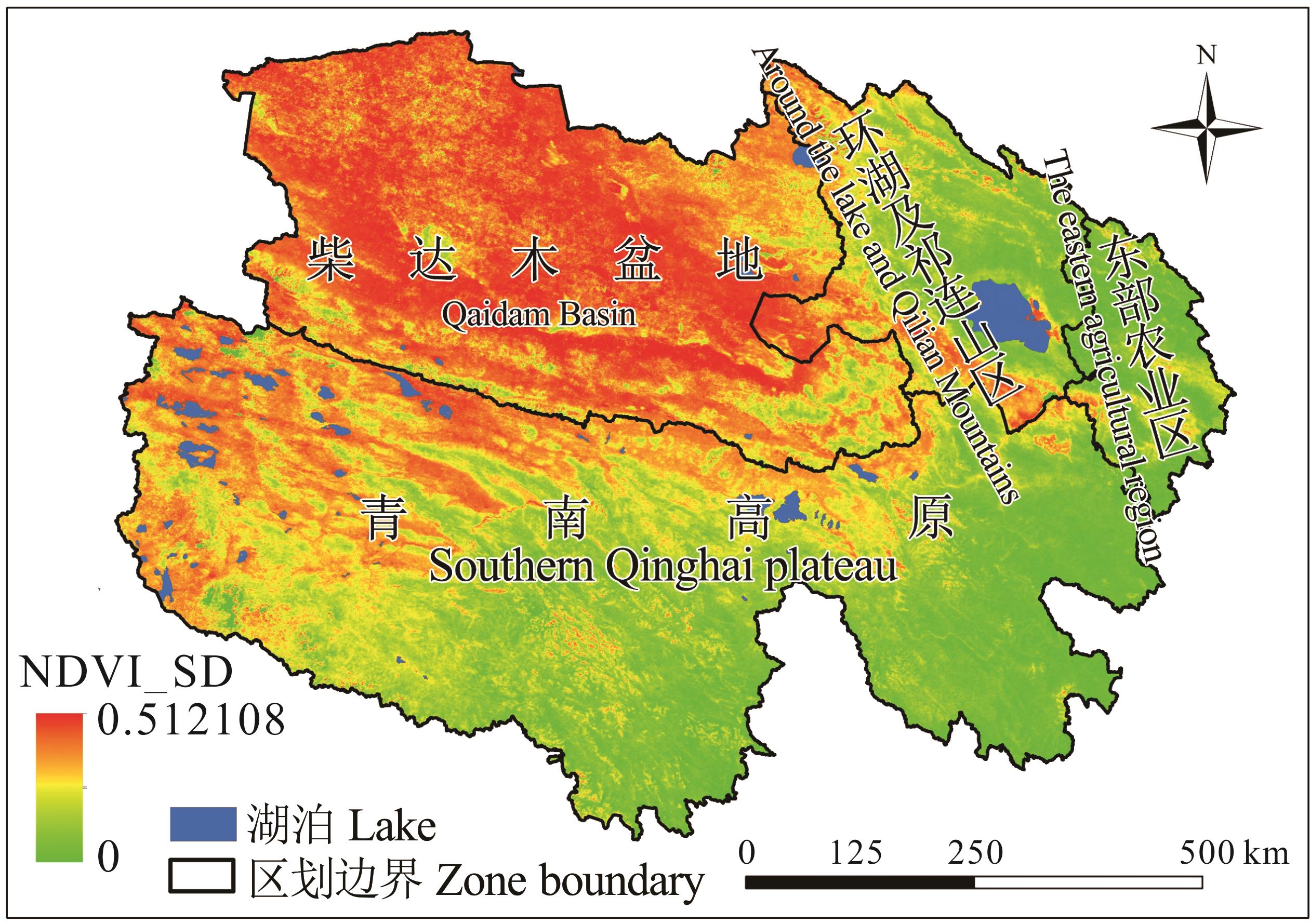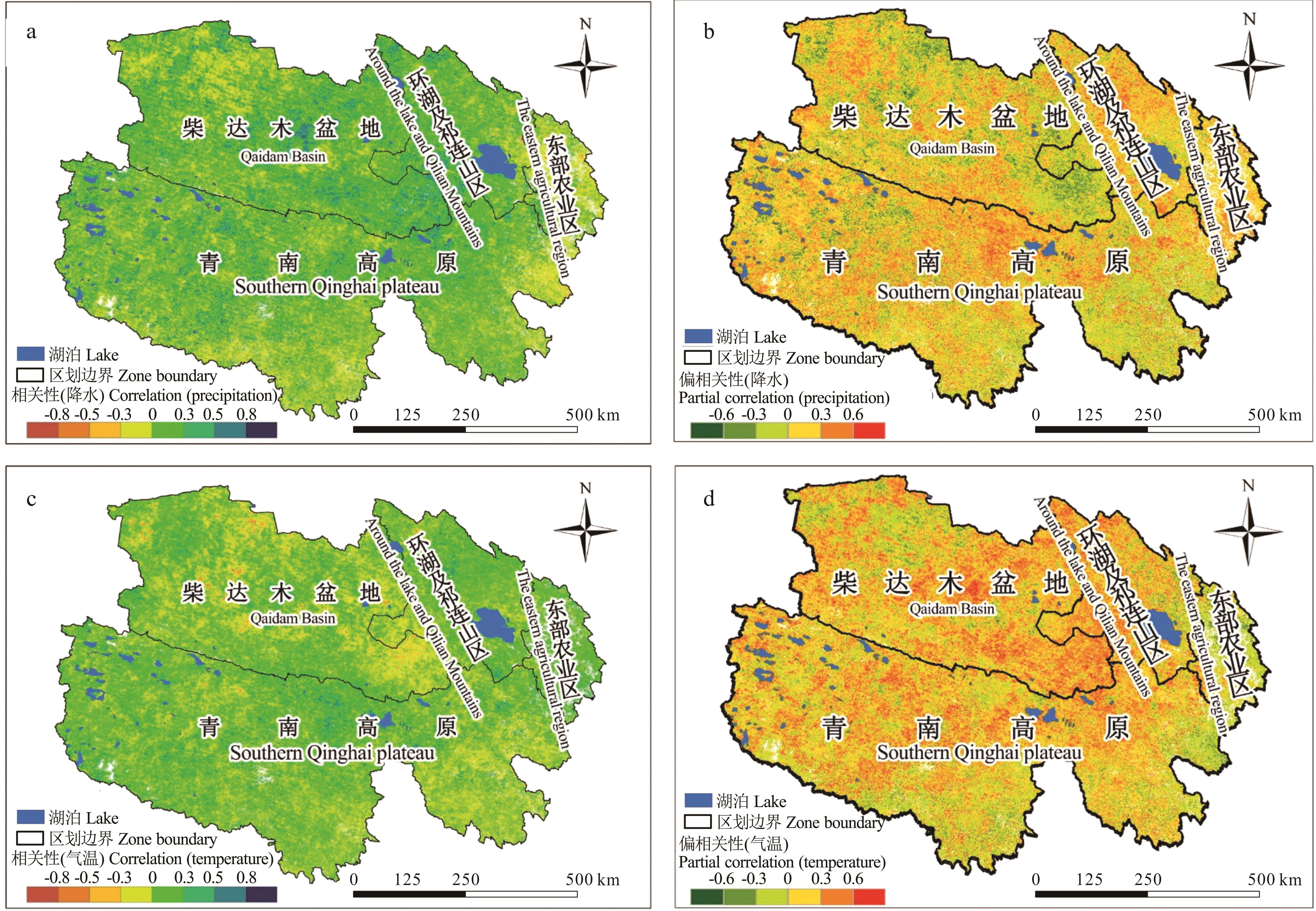

ISSN 1004-5759 CN 62-1105/S


草业学报 ›› 2021, Vol. 30 ›› Issue (9): 1-14.DOI: 10.11686/cyxb2020398
• 研究论文 •
杨鑫1( ), 曹文侠1, 鱼小军1, 汪海斌2, 郝媛媛1(
), 曹文侠1, 鱼小军1, 汪海斌2, 郝媛媛1( )
)
收稿日期:2020-08-24
修回日期:2020-12-14
出版日期:2021-08-30
发布日期:2021-08-30
通讯作者:
郝媛媛
作者简介:Corresponding author. E-mail: haoyy@gsau.edu.cn基金资助:
Xin YANG1( ), Wen-xia CAO1, Xiao-jun YU1, Hai-bin WANG2, Yuan-yuan HAO1(
), Wen-xia CAO1, Xiao-jun YU1, Hai-bin WANG2, Yuan-yuan HAO1( )
)
Received:2020-08-24
Revised:2020-12-14
Online:2021-08-30
Published:2021-08-30
Contact:
Yuan-yuan HAO
摘要:
草地植被遥感动态监测是明晰草地植被时空动态变化过程的重要手段,是探索植被对环境因子响应规律的有效依据。以MOD09GA为数据源,采用最大值合成、一元回归趋势分析、相关性分析等方法,分别从日、旬、月和年尺度探究了2000-2019年青海省草地植被归一化植被指数(NDVI)时空动态变化过程及其与环境因子(海拔、坡度、坡向、气温和降水)的响应关系,以期为黄河流域源头生态保护和高质量发展提供理论依据。结果表明:1)草地植被NDVI逐日变化趋势稳定;旬际波动以2010年为顶点,先增后减但整体向好,且返青期提前、最大值日期集中且推后;草地植被长势变好,生长期延长;多年平均NDVI从西北向东南逐渐升高。2)草地质量自东南向西北递减,优质草地以4500~5000 m为中心向两侧递减,普通草地随海拔增高先减后增再减,退化草地随海拔升高逐渐减少;各级草地面积随坡度增大及阴坡→阳坡→半阴半阳的坡向逐渐减小。3)2000-2015年降水及气温均上升,且气温上升更明显;降水和气温分别呈现自东南向西北递减和南北低中部高的格局;NDVI与降水相关性高于气温6.76%。
杨鑫, 曹文侠, 鱼小军, 汪海斌, 郝媛媛. 基于近20年MODIS NDVI日数据的青海省草地资源动态监测及其对环境因子的响应[J]. 草业学报, 2021, 30(9): 1-14.
Xin YANG, Wen-xia CAO, Xiao-jun YU, Hai-bin WANG, Yuan-yuan HAO. Dynamic monitoring of grassland resources and their responses to environmental factors in Qinghai Province based on analyses of daily MODIS NDVI data from the past 20 years[J]. Acta Prataculturae Sinica, 2021, 30(9): 1-14.
| 类别Class | 类型Type | NDVI值NDVI value |
|---|---|---|
| Ⅰ | 冰雪覆盖 Cryoconite cover | -1.0~0 |
| Ⅱ | 无植被区No vegetation area | 0~0.1 |
| Ⅲ | 退化草地Depleted grassland | 0.1~0.4 |
| Ⅳ | 普通草地Ordinary grassland | 0.4~0.7 |
| Ⅴ | 优质草地High quality grassland | 0.7~1.0 |
表1 青海省草地植被生长状况等级
Table 1 Growth status of grassland vegetation in Qinghai Province
| 类别Class | 类型Type | NDVI值NDVI value |
|---|---|---|
| Ⅰ | 冰雪覆盖 Cryoconite cover | -1.0~0 |
| Ⅱ | 无植被区No vegetation area | 0~0.1 |
| Ⅲ | 退化草地Depleted grassland | 0.1~0.4 |
| Ⅳ | 普通草地Ordinary grassland | 0.4~0.7 |
| Ⅴ | 优质草地High quality grassland | 0.7~1.0 |

图2 2000-2019年青海省及其各地区草地植被NDVI日均动态变化
Fig.2 Daily average dynamic changes of grassland vegetation NDVI in various regions of Qinghai Province from 2000 to 2019

图4 2000-2019年青海省各地区旬度草地植被返青时间动态变化1:7月上旬Early July; 2:6月下旬Late June; 3:6月中旬Middle of June; 4:6月上旬Early June; 5:5月下旬Late May; 6:5月中旬Middle of May; 7:5月上旬Early May; 8:4月下旬Late April; 9:4月中旬Middle of April; 10:4月上旬Early April.
Fig.4 Dynamic changes of the start of growning season time of ten-days grassland vegetation in various regions of Qinghai Province from 2000 to 2019

图5 2000-2019年青海省各地区草地植被旬度最大值动态变化1:8月上旬Early August;2:7月下旬Late July;3:6月中旬Middle of July;4:7月上旬Early July;5:6月下旬Late June;6:6月中旬Middle of June;7:6月上旬Early June;8:5月下旬Late May.
Fig.5 Dynamic changes of the ten-days maximum of grassland vegetation in various regions of Qinghai Province from 2000 to 2019

图7 2000-2019年青海省草地植被分布及NDVI变化趋势A:无植被区There is no vegetation area; B:退化草地Depleted grassland; C:普通草地Ordinary grassland; D:优质草地High quality grassland.
Fig.7 Vegetation distributions and NDVI variation trends in Qinghai Province from 2000 to 2019
区名 District name | 退化 Deterioration | 轻度退化 Mild deterioration | 稳定 Stablilzation | 轻度改善 Mild improvement | 改善 Improvement |
|---|---|---|---|---|---|
| 青海省Qinghai Province | 15.79 | 28.54 | 12.97 | 29.94 | 12.75 |
| 环湖及祁连山区Around the lake and Qilian Mountains | 9.91 | 29.19 | 13.31 | 34.49 | 13.10 |
| 柴达木盆地Qaidam Basin | 27.84 | 24.17 | 5.92 | 22.68 | 19.39 |
| 青南高原Southern Qinghai Plateau | 11.09 | 30.88 | 15.66 | 32.80 | 9.57 |
| 东部农业区The eastern agricultural region | 3.28 | 29.93 | 27.88 | 35.02 | 3.89 |
表2 2000-2019年青海省及其各地区草地植被生长变化趋势占比
Table 2 Grassland change trends in various regions of Qinghai Province from 2000 to 2019 (%)
区名 District name | 退化 Deterioration | 轻度退化 Mild deterioration | 稳定 Stablilzation | 轻度改善 Mild improvement | 改善 Improvement |
|---|---|---|---|---|---|
| 青海省Qinghai Province | 15.79 | 28.54 | 12.97 | 29.94 | 12.75 |
| 环湖及祁连山区Around the lake and Qilian Mountains | 9.91 | 29.19 | 13.31 | 34.49 | 13.10 |
| 柴达木盆地Qaidam Basin | 27.84 | 24.17 | 5.92 | 22.68 | 19.39 |
| 青南高原Southern Qinghai Plateau | 11.09 | 30.88 | 15.66 | 32.80 | 9.57 |
| 东部农业区The eastern agricultural region | 3.28 | 29.93 | 27.88 | 35.02 | 3.89 |

图8 2000-2019年青海省草地植被NDVI波动幅度NDVI_SD: 归一化植被指数_标准差Normalized difference vegetation index_standard deviation.
Fig.8 Fluctuation ranges of NDVI in Qinghai Province from 2000 to 2019

图9 2000-2019年青海省不同海拔、坡度和坡向分布及各级草地面积
Fig.9 Distributions and grassland areas of different altitudes, slopes and aspects in Qinghai Province from 2000 to 2019

图11 2000-2015年青海省草地植被NDVI与降水和气温的相关及偏相关性
Fig.11 Correlation and partial correlation coefficients between grassland vegetation NDVI and precipitation or temperature in Qinghai Province from 2000 to 2015
| 1 | Li B. The rangeland degradation in North China and it’s preventive strategy. Chinese Agricultural Sciences, 1997(6): 2-10. |
| 李博. 中国北方草地退化及其防治对策. 中国农业科学, 1997(6): 2-10. | |
| 2 | Lv X, Wang J L, Kang H J, et al. Grass-stock balance analysis in Guoluo and Yushu areas of Qinghai Province from 2006 to 2015 based on estimation of yield by remote sensing. Journal of Natural Resources, 2018, 33(10): 1821-1832. |
| 吕鑫, 王卷乐, 康海军, 等. 基于遥感估产的2006-2015年青海果洛与玉树地区草畜平衡分析. 自然资源学报, 2018, 33(10): 1821-1832. | |
| 3 | Zhang G S, Fu Y, Yang Q, et al. Spatial distribution characteristics and climate zoning of natural grassland types in Qinghai Province. Pratacultural Science, 2009, 26(1): 23-29. |
| 张国胜, 伏洋, 杨琼, 等. 青海省天然草地类型空间分布特征及气候分区. 草业科学, 2009, 26(1): 23-29. | |
| 4 | Qing D H. Highlights of the report of the first working group of the IPCC fifth assessment report. Progress in Climate Change Research, 2014, 10(1): 1-6. |
| 秦大河. IPCC第五次评估报告第一工作组报告的亮点结论. 气候变化研究进展, 2014, 10(1): 1-6. | |
| 5 | Gottfried M, Pauli H, Futschik A, et al. Continent-wide response of mountain vegetation to climate change. Nature Climate Change, 2012, 2(2): 111-115. |
| 6 | Wu D H, Zhao X, Liang S L, et al. Time-lag effects of global vegetation responses to climate change. Global Change Biology, 2015, 21(9): 3520-3531. |
| 7 | Zhang J, Yuan M S, Zhang J, et al. The response of the NDVI dynamic changes of the alpine grassland on the Qinghai-Tibet Plateau to natural and human factors in the past 30 years. Acta Ecologica Sinica, 2020, 40(18): 6269-6281. |
| 张江, 袁旻舒, 张婧, 等. 近30年来青藏高原高寒草地NDVI动态变化对自然及人为因子的响应. 生态学报, 2020, 40(18): 6269-6281. | |
| 8 | Cui B C, Zheng J H, Turxun H, et al. Spatio-temporal characteristics of grassland net primary productivity (NPP) in the Tarim River basin. Acta Prataculturae Sinica, 2020, 29(6): 1-13. |
| 崔博超, 郑江华, 吐尔逊·哈斯木, 等. 塔里木河流域草地净初级生产力时空分异特征研究. 草业学报, 2020, 29(6): 1-13. | |
| 9 | Wang T, Zhao Y Z, Wang H, et al. Temporal and spatial changes of the vegetation index of the Qinghai-Tibet Plateau based on GIMMS NDVI and its response to temperature and precipitation. Journal of Glaciology and Geocryology, 2020, 42(2): 641-652. |
| 王涛, 赵元真, 王慧, 等. 基于GIMMS NDVI的青藏高原植被指数时空变化及其气温降水响应. 冰川冻土, 2020, 42(2): 641-652. | |
| 10 | Liu T, Jiang T, Guo L J. Remote sensing monitoring of grass yields of different types of grassland in the Three River Source Region based on MODIS. Journal of Shandong University of Science and Technology (Natural Science Edition), 2018, 37(5): 18-26. |
| 刘唐, 江涛, 郭连杰. 基于MODIS的三江源地区不同类型草地草产量的遥感监测. 山东科技大学学报(自然科学版), 2018, 37(5): 18-26. | |
| 11 | Liu S L, Zhao H D, Dong S K, et al. Research on vegetation dynamic changes in Altun Mountain Nature Reserve based on SPOT NDVI. Arid Zone Research, 2014, 31(5): 832-837. |
| 刘世梁, 赵海迪, 董世魁, 等. 基于SPOT NDVI的阿尔金山自然保护区植被动态变化研究. 干旱区研究, 2014, 31(5): 832-837. | |
| 12 | Zhao J Y, Peng J H. Analysis on the characteristics of temporal and spatial changes of vegetation cover in Qinghai Plateau based on MODIS NDVI. Journal of Arid Land Resources and Environment, 2016, 30(4): 67-73. |
| 赵健赟, 彭军还. 基于MODIS NDVI的青海高原植被覆盖时空变化特征分析. 干旱区资源与环境, 2016, 30(4): 67-73. | |
| 13 | Zhang J H, Feng Z M, Jiang L G, et al. Analysis of the correlation between vegetation NDVI and climate factors in the Lancang River Basin. Journal of Natural Resources, 2015, 30(9): 1425-1435. |
| 张景华, 封志明, 姜鲁光, 等. 澜沧江流域植被NDVI与气候因子的相关性分析. 自然资源学报, 2015, 30(9): 1425-1435. | |
| 14 | Xu H R. Analysis of vegetation cover changes in Qinghai Province based on MODIS images. Kunming: Kunming University of Science and Technology, 2016. |
| 徐浩然. 基于MODIS影像的青海省植被覆盖变化分析. 昆明: 昆明理工大学, 2016. | |
| 15 | Wang J. Drought monitoring in Qinghai Province based on MODIS products. Changsha: Central South University, 2014. |
| 王君. 基于MODIS产品的青海省干旱监测. 长沙: 中南大学, 2014. | |
| 16 | Wang F K, Lei Y H, Du Z L, et al. The impact of climate change on the output of main crops in the Qaidam Basin. Chinese Agricultural Science Bulletin, 2020, 36(14): 107-112. |
| 王发科, 雷玉红, 都占良, 等. 气候变化对柴达木盆地主要农作物产量的影响. 中国农学通报, 2020, 36(14): 107-112. | |
| 17 | Dou Y H. Vulnerability assessment of alpine grassland in Qingnan Plateau based on AHP. Qinghai Environment, 2018, 28(3): 145-150. |
| 窦永红. 基于AHP的青南高原高寒草地脆弱性评估. 青海环境, 2018, 28(3): 145-150. | |
| 18 | Suo L Z G, Yi X Z M. Response of vegetation index (NDVI) of Qingnan Plateau to climatic factors. Farm Staff, 2019(19): 150-151. |
| 索朗卓嘎, 益西卓玛. 青南高原植被指数(NDVI)对气候因子的响应. 农家参谋, 2019(19): 150-151. | |
| 19 | Liu F, Zeng Y N. Changes in the temporal and spatial patterns of vegetation NPP on the Qinghai Plateau in the past 16 years and the effects of climate and human factors. Acta Ecologica Sinica, 2019, 39(5): 1528-1540. |
| 刘凤, 曾永年. 近16年青海高原植被NPP时空格局变化及气候与人为因素的影响. 生态学报, 2019, 39(5): 1528-1540. | |
| 20 | Zhang X P, He W, Fang T. Emergy analysis of agricultural eco-economic system in Huangshui Valley-Taking Xining City as an example. Arid Land Geography, 2011, 34(2): 344-354. |
| 张小平, 何伟, 方婷. 湟水谷地农业生态经济系统的能值分析——以西宁市为例. 干旱区地理, 2011, 34(2): 344-354. | |
| 21 | Lu L P, Zhao C Y. Study on the spatial change of different desert vegetation indexes based on MODIS Data-Taking Sangong River Basin in Xinjiang as an example. Arid Land Geography, 2005, 28(3): 381-385. |
| 卢丽萍, 赵成义. 基于MODIS数据不同荒漠植被指数的空间变化研究——以新疆三工河流域为例. 干旱区地理, 2005, 28(3): 381-385. | |
| 22 | Liu Y, Li Y, Cui C X, et al. Application evaluation of MODIS MOD13Q1 data in desertification monitoring in Northern Xinjiang. Acta Prataculturae Sinica, 2010, 19(3): 14-21. |
| 刘艳, 李杨, 崔彩霞, 等. MODIS MOD13Q1数据在北疆荒漠化监测中的应用评价. 草业学报, 2010, 19(3): 14-21. | |
| 23 | Wei Y X, Wang L W, Liu C. Grassland classification in Qinghai Province based on MODIS NDVI time series data. Resources Science, 2008, 30(5): 688-693. |
| 卫亚星, 王莉雯, 刘闯. 基于MODIS NDVI时序数据的青海省草地分级. 资源科学, 2008, 30(5): 688-693. | |
| 24 | Yang S X, Zhang W J, Feng Q S, et al. Remote sensing monitoring of grassland growth in Qingnan area based on MODIS daily surface reflectance data. Acta Prataculturae Sinica, 2016, 25(8): 14-26. |
| 杨淑霞, 张文娟, 冯琦胜, 等. 基于MODIS逐日地表反射率数据的青南地区草地生长状况遥感监测研究. 草业学报, 2016, 25(8): 14-26. | |
| 25 | Sun L G, Liu J F, Xu Q H. Spatio-temporal analysis of vegetation cover changes in Hebei Bashang area. Remote Sensing for Land and Resources, 2014, 26(1): 167-172. |
| 孙雷刚, 刘剑锋, 徐全洪. 河北坝上地区植被覆盖变化遥感时空分析. 国土资源遥感, 2014, 26(1): 167-172. | |
| 26 | Christian K. Mountain Ecosystems: Studies in treeline ecology. John Wiley & Sons, Ltd, 2005, 86(42): 401. |
| 27 | Dai Z J, Zhao X, Li G W, et al. Based on GIMMS NDVI 3g.v1, the characteristics of spatial and temporal changes of NDVI in the vegetation growing season in Qinghai Province in recent 34 years. Pratacultural Science, 2018, 35(4): 713-725. |
| 代子俊, 赵霞, 李冠稳, 等. 基于GIMMS NDVI 3g.v1的近34年青海省植被生长季NDVI时空变化特征. 草业科学, 2018, 35(4): 713-725. | |
| 28 | Zhao W L, Luo T X, Zhang L. The relative influence of climate change and grazing on the vegetation index of typical alpine desert grassland in Tibet. Acta Ecologica Sinica, 2019, 39(22): 8494-8503. |
| 赵旺林, 罗天祥, 张林. 气候变化与放牧对西藏典型高寒荒漠草地植被指数变化的相对影响. 生态学报, 2019, 39(22): 8494-8503. | |
| 29 | Zhao X Y, Wan W Y, Wang W J. The impact of climate change in the past 50 years on the production potential and phenological period of forages on the Qinghai-Tibet Plateau. Chinese Journal of Eco-Agriculture, 2016, 24(4): 532-543. |
| 赵雪雁, 万文玉, 王伟军. 近50年气候变化对青藏高原牧草生产潜力及物候期的影响. 中国生态农业学报, 2016, 24(4): 532-543. | |
| 30 | Yang Y H. Carbon and nitrogen storage in alpine grasslands on the Tibetan Plateau. Beijing: Peking University, 2008. |
| 杨元合. 青藏高原高寒草地生态系统碳氮储量. 北京: 北京大学, 2008. | |
| 31 | Chen J J, Yi S H, Qin Y, et al. The response of alpine grassland landscape to topographical factors and frozen soil types in the source area of the Shule River. Chinese Journal of Applied Ecology, 2014, 25(6): 1599-1606. |
| 陈建军, 宜树华, 秦彧, 等. 疏勒河源区高寒草地景观对地形因子和冻土类型的响应. 应用生态学报, 2014, 25(6): 1599-1606. | |
| 32 | Wang P L, Tang G L, Cao L J, et al. Surface air temperature variability and its relationship with altitude & latitude over the Tibetan Plateau in 1981-2010. Advances in Climate Change Research, 2012, 8(5): 313-319. |
| 33 | Zhang T R, Yan L D, Zhang F, et al. The impacts of climate on the natural pasture grass in Qinghai Province. Plateau Meteorology, 2007, 26(4): 724-731. |
| 34 | Lv X R, Lv X Y. Climate tendency analysis warming and drying in grassland of Northeast Qingzang Plateau of China. Grassland of China, 2002, 24(4): 8-13. |
| 35 | Yang Y H, Fang J Y, Pan Y D, et al. Aboveground biomass in Tibetan grasslands. Journal of Arid Environments, 2009, 73(1): 91-95. |
| [1] | 林小丁, 常乐, 冯丹. 2000-2019年青海地区植被总初级生产力遥感估算及时空变化分析[J]. 草业学报, 2021, 30(6): 16-27. |
| [2] | 陈宸, 井长青, 邢文渊, 邓小进, 付皓宇, 郭文章. 近20年新疆荒漠草地动态变化及其对气候变化的响应[J]. 草业学报, 2021, 30(3): 1-14. |
| [3] | 杜佳梦, 包刚, 佟斯琴, 黄晓君, 温都日娜, 美丽, 包玉海. 1982-2015年蒙古国植被覆盖变化及其与气候变化和人类活动的关系[J]. 草业学报, 2021, 30(2): 1-13. |
| [4] | 孙思思, 吴战平, 肖启涛, 于飞, 古书鸿, 方荻, 李浪, 赵兴炳. 云贵高原草地生态系统CO2通量变化特征[J]. 草业学报, 2020, 29(4): 184-191. |
| [5] | 赵慧芳, 李晓东, 张东, 校瑞香. 基于MODIS数据的青海省草地地上生物量估算及影响因素研究[J]. 草业学报, 2020, 29(12): 5-16. |
| [6] | 乌尼图, 刘桂香, 杨勇, 宋向阳, 白海花. 基于光能利用率模型的内蒙古天然草原植被净初级生产力动态监测与气候因子的响应[J]. 草业学报, 2020, 29(11): 1-10. |
| [7] | 倪璐, 吴静, 李纯斌, 秦格霞, 李政, 孔婕. 近30年中国天然草地物候时空变化特征分析[J]. 草业学报, 2020, 29(1): 1-12. |
| [8] | 沈贝贝, 丁蕾, 李振旺, 辛晓平, 徐大伟, 朱晓昱, 王旭, 陈宝瑞. 呼伦贝尔草原净初级生产力时空变化及气候响应分析[J]. 草业学报, 2019, 28(5): 1-14. |
| [9] | 李重阳, 樊文涛, 李国梅, 高晶, 唐增, 宋仁德. 基于NDVI的2000-2016年青藏高原牧户草场覆盖度变化驱动力分析[J]. 草业学报, 2019, 28(10): 25-32. |
| [10] | 孙丽坤, 刘光琇, 张宝贵, 章高森. 环境因子对中国柽柳遗传变异的影响[J]. 草业学报, 2019, 28(10): 178-186. |
| [11] | 陆姣云,段兵红,杨梅,杨晗,杨惠敏. 植物叶片氮磷养分重吸收规律及其调控机制研究进展[J]. 草业学报, 2018, 27(4): 178-188. |
| [12] | 李红梅. 柴达木盆地气候变化对植被的影响分析[J]. 草业学报, 2018, 27(3): 13-23. |
| [13] | 范顺祥, 郑建伟, 魏士凯, 黄选瑞, 张志东. 河北省森林草原区主要草本植物功能群适宜分布预测[J]. 草业学报, 2018, 27(3): 24-32. |
| [14] | 葛静, 孟宝平, 杨淑霞, 高金龙, 殷建鹏, 张仁平, 冯琦胜, 梁天刚. 基于ADC和MODIS遥感数据的高寒草地地上生物量监测研究——以黄河源区为例[J]. 草业学报, 2017, 26(7): 23-34. |
| [15] | 葛兆轩, 孙国龙, 袁业, 黄选瑞, 张志东. 河北省森林草原区草本植物物种多样性和功能多样性[J]. 草业学报, 2017, 26(7): 35-44. |
| 阅读次数 | ||||||
|
全文 |
|
|||||
|
摘要 |
|
|||||